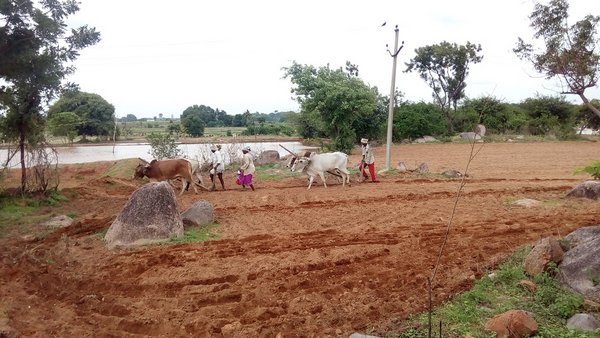 Read this article in French
Read this article in French- Share this article
- Subscribe to our newsletter
Community-based natural farming outshines other farming practices in Andhra Pradesh
Andhra Pradesh’s Community-Based Natural Farming (APCNF) defies the popular belief that chemical fertilisers guarantee better yields. According to a comparative study of prevalent farming practices in the state conducted over two years in three districts of Andhra Pradesh, natural farming achieved remarkable results compared to other dominant farming systems in the region. On average, farmers practising natural farming harvested four crops, with an eleven per cent higher yield of prime crops such as paddy rice, maize, millet, finger millets and red gram. They saw a 49 per cent net increase in their income.
To encourage natural farming, in March this year, the Government of India, formulated the National Mission on Natural Farming (NMNF) with an initial budget of Rs. 4.59 billion for 2023-24.
Although many governments, including India’s, express interest in natural farming techniques, there is limited scientific literature that compares APCNF’s costs and benefits with prevalent farming systems, says the study, which aims to fill the gap by providing evidence-based evaluation of natural farming in Andhra Pradesh to encourage a broader global uptake.
Study methodologies and findings
Led by impact data and analytics provider, GIST Impact, and supported by the Global Alliance for the Future of Food, the study compared the effects of Community-Managed Natural Farming (CNF) with three other farming systems prevalent in the region – chemical farming in the Godavari delta region, rainfed farming in the semi-arid region and low-input tribal farming in the mountainous region.
The researchers used the Economics of Ecosystems and Biodiversity for Agriculture and Food Systems (TEEBAgriFood), a framework that evaluates ecosystem services, biodiversity and human health to promote sustainable practices. Looking at data between 2020 and 2022, they evaluated yields in 13 districts using crop-cutting experiments and surveyed 562 farming households in three districts with diverse agroecological conditions, comparing CNF with counterfactual villages. The research covered twelve villages across three zones, representing around ten per cent of total farming households in the region.
Better results in all aspects
The research found that CNF farmers surveyed enjoy better results in all aspects – production, economic, social and health impacts.
For example, CNF farmers grew an average of 4.51 crops compared to 2.16 in low-input tribal farming, 4.88 compared to 2.40 in rainfed farming and 2.92 compared to 1.84 in high-input farming. The adoption of CNF led to higher crop diversity, with an average of 4 crops compared to 2.1 on the counterfactual farms.
Additionally, it was found that CNF farmers experienced a 44 per cent reduction in input costs (such as fertilisers and pesticides) compared to counterfactual farms across three regions. They also saw an average yield increase ranging from 7.8 per cent to 25.9 per cent. Overall, CNF adoption boosts gross income per hectare by $684 (+28.3 per cent) across all three regions.
Women playing a significant role
The study underlines CNF’s success in fostering social capital within the community, with women playing a significant role at the household level. CNF villages scored higher in all six dimensions of social capital, including information provision, mutuality, collective action, trust and support, community cohesion and risk reduction.
The findings indicate an intriguing relationship between land ownership and the social capital index, suggesting that smallholder farmers actively contribute to generating social capital. As agricultural land ownership increases, the social capital index decreases.
The study also highlights a notable difference in health impacts, indicating that CNF farming is associated with reduced on-farm health risks. On average, CNF farmers lose 121 work days yearly due to illnesses, while farmers in counterfactual systems lose 189 work days. Additionally, the household diet diversity score (HDDS) reveals that surveyed farmer households have a greater macronutrient diversity in their diets compared to the average Andhra food plate, showcasing their access to a wider range of food crops.
(Kundan Pandey, Mongabay / pas)
More information:





Add a comment
Be the First to Comment